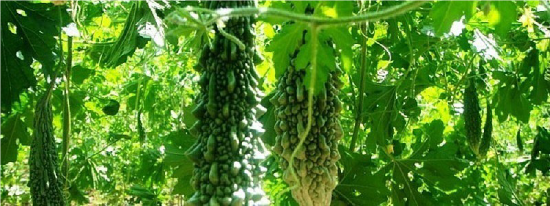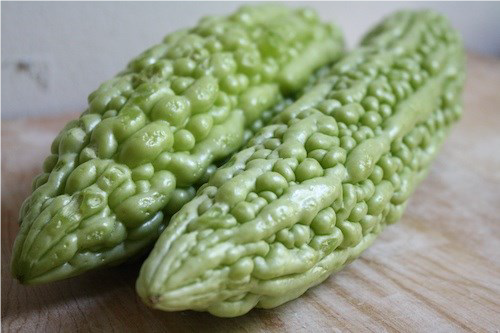Bitter Melon
 Bitter Melon is a member of the squash family and is very popular in Asia, Africa, the Caribbean, India, and Middle Eastern countries. Bitter Melon has a bumpy skin and ranges from light to dark yellowish green in color and oblong in shape as the bitter melon matures and ripens it turns yellow-orange. As the fruit ripens, it becomes tougher and very bitter. The two major varieties are the Chinese (smooth skin) and the Indian (bumpy skin). The former is longer and larger in size (usually 8 to 12 inches in length and 2 to 3 inches in diameter), smooth, light green in color, and oblong-shaped with a distinct warty appearance. The latter is shorter and smaller in size with rough skin, dark green coloration, and pointed ends. Both types have ridges, but Chinese bitter melon ridges are smooth, and Indian bitter melon ridges are pointed. Bitter Melon is very common in Asian and Indian dishes.
Bitter Melon is a member of the squash family and is very popular in Asia, Africa, the Caribbean, India, and Middle Eastern countries. Bitter Melon has a bumpy skin and ranges from light to dark yellowish green in color and oblong in shape as the bitter melon matures and ripens it turns yellow-orange. As the fruit ripens, it becomes tougher and very bitter. The two major varieties are the Chinese (smooth skin) and the Indian (bumpy skin). The former is longer and larger in size (usually 8 to 12 inches in length and 2 to 3 inches in diameter), smooth, light green in color, and oblong-shaped with a distinct warty appearance. The latter is shorter and smaller in size with rough skin, dark green coloration, and pointed ends. Both types have ridges, but Chinese bitter melon ridges are smooth, and Indian bitter melon ridges are pointed. Bitter Melon is very common in Asian and Indian dishes.
Bitter Melon is a subtropical and tropical vine of the family of Cucurbitaceae. Bitter Melon can be grown in Kansas (both greenhouse and field), seeds can be directly started in the soil in late spring/ early summer. Bitter Melon is a warm season crop, it thrives in hot and humid conditions. Bitter Melon varieties trail and benefit from growing on a trellis which makes the fruit easy to harvest. If you don’t trellis, spread hay or pine straw on the ground for the fruit to grow on, don’t allow the fruit to grow on the ground, this causes the fruit to rot and disease will develop. Distance between rows should be 5 to 6 feet and spacing between plants should be between 3 and 5 feet.
- Sunlight: This vine prefers partial shade to full sun with 6 hours or more light preferred.
- Temperature: Wait to plant outside till temperatures are averaging 70 degrees or warmer for this tropical vine. The seeds may fail to germinate if soil is too dry or cold.
- Watering: This vine is tropical to subtropical in origin. Water similar to a cucumber.
- Soil and Fertilization: Soil should be fertile, well drained and in soil with a pH of 5.5 to 6.7.
- Transplanting: If you have the space you can start seeds in a greenhouse and transplant
and grow until seedlings are ready for outside in Kansas, after the last frost or when temperature is around 70 F. - Pests and Diseases: Bitter Melon like other members of the squash and cucumber family can develop Powdery Mildew, Downy Mildew, Rust and Rots.
 Fruits are ready to harvest from 40 –63 days after planting depending on the
Fruits are ready to harvest from 40 –63 days after planting depending on the
variety. Harvest fruits when they are 4 to 8 inches long, more mature fruits are not as bitter and bitterness can vary from fruit to fruit on the same plant. Bitterness is the result of the alkaloid momordicine
found in growing bitter melons; the darker the color of a Bitter Melon the more bitter and intense the flavor of the fruit. Harvest fruit, when they are small and skin is green in color, they are less bitter. Bitter Melon is a herbaceous vine. The skin is tender and edible, the seeds and pit appear white in unripe fruit. Try to eat or freeze bitter melon within a few days of harvest. Once the fruit begins to degrade it will quickly mold and turn bad.
Bitter melon is highly nutritious. It has almost as much potassium as a banana and is an excellent source of vitamins C and A. Some research indicates that bitter melon may help reduce inflammation, and thus reduce the risk of many chronic diseases, such as diabetes, cancer and heart disease. Use caution if you are eating large amounts of bitter melon or taking bitter melon supplements. It may interfere with some diabetes medications causing blood sugars to dip too low.
Bitter Melon Shrimp Egg Pie
| Ingredients | Directions |
| 1/2 Bitter Melon, seeded, cut into thin strips 1/2 cup shrimp, peeled, de-veined 1 egg, beaten, whisked lightly with a dash of salt 2 Tbs Vegetable oil for stir-frying |
|
Recipe source: Tennessee State University Extension
Stuffed Bitter Melon
| Ingredients | Directions |
|
|
Recipe source: Tennessee State University Extension
Indian Style Bitter Melon
| Ingredients | Directions |
|
|
Recipe source: Tennessee State University Extension